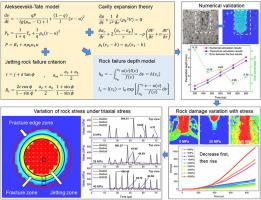三轴应力下磨料水射流破岩新理论及岩石损伤演化机制
IF 7.5
1区 工程技术
Q1 ENGINEERING, GEOLOGICAL
International Journal of Rock Mechanics and Mining Sciences
Pub Date : 2025-09-22
DOI:10.1016/j.ijrmms.2025.106258
引用次数: 0
摘要
地球深部工程对国家发展至关重要,但在深部坚硬地层中岩石破碎仍然是一个重大挑战。磨料水射流(AWJ)技术显示出相当大的前景,但目前的模型往往忽略了地应力效应,限制了其有效性。结合Alekseevskii-Tate (AT)长杆贯入模型、射流理论和改进的球腔扩展模型,提出了三轴应力下AWJ破岩判据。分析了弹性区、开裂区和破碎区的力学行为,建立了三轴应力作用下的侵彻深度模型。采用SPH-FEM耦合模拟研究了应力对射流应力波、岩石损伤和能量演化的影响,从而阐明了岩石破碎过程中的破坏机制。结果表明:应力对波的传播和损伤模式有显著影响:在0 MPa时,波自由膨胀;在25 MPa时,波浪膨胀受到限制,减少了损伤;在40兆帕时,波浪集中,伤害增加。数值和理论结果表明,平均误差为6.59%,验证了模型的准确性。随着应力的增加,岩石质量先快速下降后缓慢下降,损伤服从二次函数。与0 MPa相比,15 MPa时总能量下降19.75%,40 MPa时总能量上升76.31%。射流区的损伤表现为脆性破坏,不受应力影响;而应力主要影响破碎区和边缘区的损伤,在低应力下抑制损伤,在高应力下促进损伤。这些发现加深了对AWJ切割作用下岩石损伤演化的认识,为优化深层岩体中AWJ网格切割参数提供了理论依据。本文章由计算机程序翻译,如有差异,请以英文原文为准。

A novel theory of abrasive water jet rock breaking under triaxial stress and the evolution mechanisms of rock damage
Deep Earth engineering is essential for national development, but rock fragmentation in deep, hard formations remains a significant challenge. Abrasive water jet (AWJ) technology shows considerable promise, yet current models often overlook geostress effects, limiting its effectiveness. This study proposes a new criterion for AWJ rock breaking under triaxial stress, combining the Alekseevskii–Tate (AT) long-rod penetration model, jet theory, and a modified spherical cavity expansion model. The mechanical behavior of the elastic, cracking, and crushing zones is analyzed, and a penetration depth model under triaxial stress is developed. Coupled SPH–FEM simulations are used to investigate how stress affects jet-induced stress waves, rock damage, and energy evolution, thereby clarifying the failure mechanism in rock breaking. Results show that stress significantly influences wave propagation and damage patterns: at 0 MPa, waves expand freely; at 25 MPa, wave expansion is restricted, reducing damage; at 40 MPa, waves concentrate, increasing damage. Numerical and theoretical results show an average error of 6.59 %, confirming the model's accuracy. As stress increases, rock quality decreases rapidly at first and then more slowly, with damage following a quadratic function. Compared to 0 MPa, total energy drops by 19.75 % at 15 MPa and rises by 76.31 % at 40 MPa. Damage in the jet zone exhibits brittle failure, unaffected by stress; while stress mainly influences damage in the crushing and edge zones, suppressing damage at low stress and promoting damage at high stress. These findings deepen the understanding of the damage evolution of rock under AWJ cutting, providing a theoretical basis for optimizing the parameters of AWJ grid cutting in deep rock masses.
求助全文
通过发布文献求助,成功后即可免费获取论文全文。
去求助
来源期刊
CiteScore
14.00
自引率
5.60%
发文量
196
审稿时长
18 weeks
期刊介绍:
The International Journal of Rock Mechanics and Mining Sciences focuses on original research, new developments, site measurements, and case studies within the fields of rock mechanics and rock engineering. Serving as an international platform, it showcases high-quality papers addressing rock mechanics and the application of its principles and techniques in mining and civil engineering projects situated on or within rock masses. These projects encompass a wide range, including slopes, open-pit mines, quarries, shafts, tunnels, caverns, underground mines, metro systems, dams, hydro-electric stations, geothermal energy, petroleum engineering, and radioactive waste disposal. The journal welcomes submissions on various topics, with particular interest in theoretical advancements, analytical and numerical methods, rock testing, site investigation, and case studies.

 求助内容:
求助内容: 应助结果提醒方式:
应助结果提醒方式:


